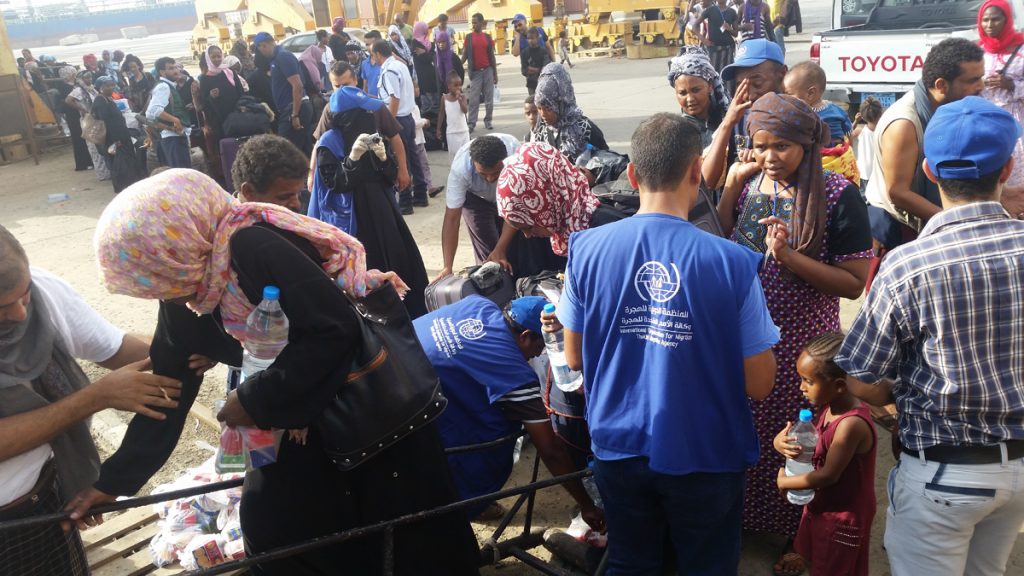By Akanimo Sampson
The governments of Tanzania and Ethiopia are currently working together to facilitate the release and return of irregular migrants from their countries. The cooperation has made the return of 463 Ethiopian migrants possible this February.
For Tamrat and Debebe, two young men who were among the returnees, the costs of dangerous, sometimes lethal passages some irregular migrants make in Africa can be measured in many ways: in currencies, even in lives and also in their hardships in years.
While the two countries are working together, the International Organisation for Migration (IOM) with the European Union (EU) is providing the post-arrival assistance. The most recent return flight arrived Monday.
Since childhood, Tamrat had dreamed of becoming a doctor or an engineer. As he did not make it to college, he decided to migrate and try working in South Africa instead.
A smuggler promised the 26-year-old he would travel to Kenya by bus and then fly the rest of the way south. Like most migrants on Africa’s so-called Southern Route, Tamrat paid between 100,000 and 180,000 birrs ($3,150 and 5,600) for the journey.
Encouraged by more successful peers, many Ethiopian migrants, most of them, hail from the southern part of the country, the dream of going to South Africa for work.
But Tamrat’s dream was shattered when the lorry in which he was being smuggled – along with 65 others – attracted the attention of authorities.
Even at that, he conceded, he considers himself lucky. “If we had not been intercepted by the police, some of us would have died of suffocation”, the young man said.
Still, he regrets his choice. “I was in prison for three years after the truck I was smuggled in was intercepted by the police,” he explained.
Debebe, another returnee from southern Ethiopia, spent four years in Tanzanian detention. He was a street cobblestone carver before leaving Ethiopia, also to chase his dream working in South Africa. Debebe paid 150,000 Birr ($4,500) to a smuggler, explaining he took 100,000 birrs from his savings, borrowing the remaining 50,000 birrs from his family.
Tamrat and Debebe are among the first of a total of 1,400 who are scheduled to be returned this way—all Ethiopians being brought home from Tanzania in the coming weeks.
The returns are supported by the EU-IOM Joint Initiative for Migrant Protection and Reintegration in the Horn of Africa (the EU-IOM Joint Initiative), with migrants being flown from Dar es Salam to Addis Ababa’s Bole International Airport on three Ethiopian Airlines flights. The Government of Ethiopia covered the cost of the returnees’ airfare.
The programme that brought these men home is part of the larger EU-IOM Joint Initiative for Migrant Protection and Reintegration which facilitates orderly, safe, regular and responsible migration management through the development of rights-based and development-focused policies and processes on protection and sustainable reintegration. The EU-IOM Joint Initiative, backed by the EU Emergency Trust Fund for Africa covers and has been set up in close cooperation with 26 African countries.
IOM provided fitness to travel medical screening as well as clothes and shoes prior to the returnees’ departure from Tanzania. Upon arrival in Addis Ababa, IOM also provided further medical assistance, psychosocial support, temporary accommodation at its Migrant Transit Centre, and onward transportation to their communities of return.
Commissioner-General of the Tanzanian Immigration Service Department, Dr. Anna Makakala, and Ethiopia’s Ambassador to Tanzania, Yonas Yosef Sanbe, were present during pre-departure formalities conveying words of support and encouragement to returning migrants.
The tripartite roadmap contained recommendations for a road map to address detention conditions and to consider alternatives to detention, as well to prevent irregular migration and to support sustainable approaches to return and reintegration, in line with the objectives of the Global Compact for Migration.
“Irregular migration is not only costing many Ethiopians their savings or those of their family but also their lives,” said Hugo Genest, IOM Ethiopia’s Programme Coordinator for Assisted Voluntary Return and Reintegration and Immigration and Border Management.
Launched in December 2016 with funding from the EU Emergency Trust Fund for Africa (EUTF), the EU-IOM Joint Initiative for Migrant Protection and Reintegration is the first comprehensive programme to save lives, protect and assist migrants along key migration routes in Africa.
The EU-IOM Joint Initiative enables migrants who decide to return to their countries of origin to do so in a safe and dignified way, in full respect of international human rights standards and in particular the principle of non-refoulment.
In close cooperation with partnering state and non-state actors, it provides assistance to returning migrants to help them restart their lives in their countries of origin through an integrated approach to reintegration that supports both migrants and their communities, has the potential to complement local development, and mitigates some of the drivers of irregular migration.
The EU-IOM Joint Initiative covers and closely cooperates with 26 African countries in the Sahel and Lake Chad, the Horn of Africa, and North Africa.
The objectives of the EU-IOM Joint Initiative for Migrant Protection and Reintegration include:
Improve protection; provide direct assistance and enable the assisted voluntary return of migrants stranded along the migration routes.
Support the reintegration process of returning migrants in an integrated approach which addresses economic, social, and psychosocial dimensions and fosters the inclusion of communities of return.
Enable migrants and potential migrants to make informed decisions about their migratory journey and sensitize their communities on migration.
Strengthen migration data and communication on migratory movements as well as on the needs and vulnerabilities of migrants in order to support evidence-based policies and programme design.
Strengthen capacities of state- and non-state actors in protection and migration governance.
Contribute to the stabilization of communities at risk by revitalising the local economy, improving access to basic socio-economic infrastructures, and attempting to strengthen social cohesion.

